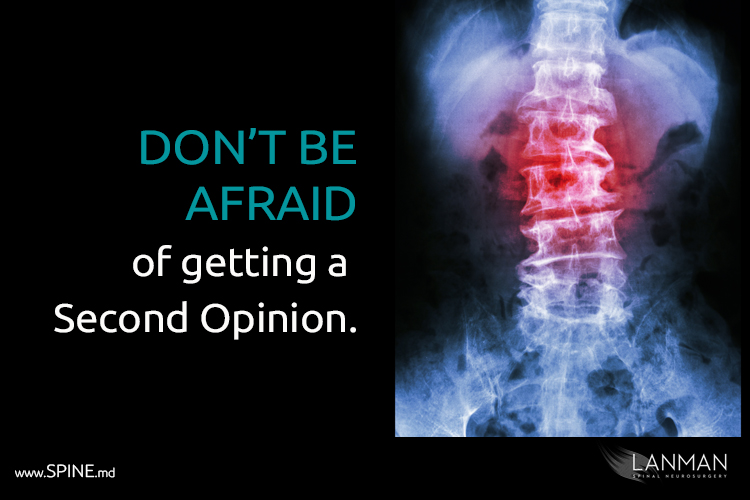Why wonder? Be bold and ask.
To answer the question – when should you seek a second opinion – any time you feel the need. We ask for second opinions when our cars need major work. Don’t we look for second opinions about vacations we want to take or new restaurants we think about dining? For any topic as important as the health of your spine, it makes sense to ask for a second opinion.
When patients come to me for advice, I must be free and open about their condition and treatment options. That kind of openness and two-way communication is vital for a healthy and productive patient-doctor relationship. That’s why I’ll easily spend an hour with a patient with an initial interview, go over the results of tests and scans, and discuss possible therapies. Even after all that time, if a patient wants a second opinion, then not only is it their right, but it’s also my sincere hope that they find the answers they are looking for.
As a neurosurgeon, my personal opinion is that if you’ve gone to a doctor whose immediate response is for you to have a spinal fusion, by all means, seek the advice of another doctor to examine you again and make sure. Fusion is not your only choice. Especially if you do not have other circumstances in your health history such as osteoarthritis or scoliosis; if you are otherwise healthy and fit, no matter your age. Spinal fusion ought to be treated as a last option.
If you hear that artificial disc replacement surgery is still “experimental” or unproven, I urge that you read the research. ADR is proven science and proven medical therapy with more than 40 years of intensive clinical and regulatory study in every major industrialized country. Artificial disc replacement is also approved by the FDA and ongoing clinical studies show superior patient outcomes.
It seems trite to ask a question about a question, but isn’t odd that we wonder about the “second opinion” at all? The 1960s television show “Marcus Welby, M.D.” gives you some idea how the perception of the medical field has changed in America. Back in those days, physicians were infallible counselors, dispensers of wisdom, and friend to all.
Back then, the phrase “family doctor” meant something. It not all that uncommon for doctors to see their patients from crib to cane. The family doctor WAS a respected and trusted member of many households. So, a second opinion was a sacrilege because it revealed a breach of trust. Even other doctors would often not cross that line and offer advice over another doctor.
Nowadays, we have conditions like “failed back surgery syndrome” (also known as FBSS, or “failed back syndrome”) which I believe is symptomatic of the significant changes in the patient-physician relationship.
Over the years, more and more patients come to me with this as their diagnosis. These patients have had various surgeries by other surgeons and find that they still have pain. Some are even worse off than before their surgeries. They come to me for a second opinion to either confirm or dispute the diagnosis.
I spend a great deal of time going over their surgical history. When I examine the patient, I go over their scans and x-rays. I dig deep into the data and analyze every aspect of their condition so that I can correctly identify the pain source. Of the dozens of such cases I’ve seen, none are more mysterious than a surgeon who made a mistake and missed a hidden diagnosis. In some cases, the treatment area is not a problem. They can miss an adjoining level where there was a degenerating disc, a bone spur, a hairline fracture. A few instances I found that patients received wrong second opinions from surgeons who didn’t realize that a fusion had failed to fully fuse (this can cause a great deal of pain). In a few cases, they didn’t detect that the patient had early signs of osteoarthritis, which can be a big game changer.
I’m not marginalizing the condition: pain is real. However, all pain has a definite, fixed cause. In my medical opinion, “FBSS” is not a true diagnosis. Although it is listed in the current catalog of medical diagnosis (ICD 10), the name itself is erroneous. It describes a condition where patients experience nonspecific pain after a recent back surgery. Some physicians blame scarring when overwhelming medical evidence disputes any association with scarring. Moreover, from a pure accuracy standpoint, the condition is not a true “syndrome” because it lacks pathogenesis.
Where the spine is concerned, when a physician knows where to look, there is rarely a hidden cause of pain that cannot be identified. I’ve been practicing spinal neurosurgery for over 25 years. I see patients at my office in Beverly Hills, CA and as part of my work as a member of the Cedars-Sinai Institute of Spinal Disorders in Los Angeles, CA. Nearly all come to me bowed by pain, some can barely hold their head up, some walk into my office with great difficulty. Among these patients, perhaps a quarter of them come to me for a second opinion.
To me, it doesn’t matter whether the patient is seeking a second opinion or I’m the first doctor they called. There are four principal types of spinal surgeries can we can offer patients: laminectomy, discectomy, spinal fusion, and artificial disc replacement. That’s not counting eight months to a year of more conservative actions that could include physical therapy, a fitness regimen, better nutrition, body chemistry analysis, or asymptomatic disease screening – just to see if other problems should be examined.
However, I don’t think about anything except how I would feel if I were sitting on the other side of my desk. And I have. I’ve been a patient of many of the procedures I prescribe. I feel the pain of post-operative recovery. I re-experience the disappointment and discomfort of new problems as they’ve cropped up. One thing that I’ve learned these parallel experiences, it takes time to find the real cause for pain and arrive at solutions. I heed to the desperation of a patient in pain as a sign that I must spend as much time as is necessary to get to the right and simple cause for their suffering. I’ll take an hour or more to study each patient’s case. According to some studies regarding spine health, patients report that many surgeons spend no more than five minutes to offer the treatment recommendation.
Five minutes.
I take that long deciding what to eat at a restaurant. It takes that long to fill my car with a tank of gas or talk to the gardener about trimming bushes. Even if the number is doubled to 10 minutes, that’s not enough time to avoid the persistence of conditions like FBSS. Tell me if I’m wrong, but is the ‘syndrome’ misplaced? Couldn’t this syndrome (and others) be a symptom?
I trust modern medical technology. I believe in my skills and ability to produce a proper diagnosis and treatment. Patients want us to spend more time with them. The second opinion is the means for them to get what they need most from me: more time.






